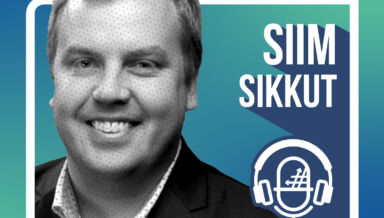As more companies return to the office, there’s something missing—people. That’s because the rise of hybrid work options means that the colleagues we once saw at the water cooler or in a conference room might be virtual that day, or maybe on a different schedule. Organizations are still fine-tuning the approach, but one thing’s for certain: employees want hybrid options and collaboration tools to support them.
I’m so happy to speak with Jared Spataro, Corporate Vice President for Microsoft 365, today on the show. Not only is Microsoft allowing its own employees to work remotely up to 50% of the time, they released a ton of insightful research on the future of hybrid work and what employees need to stay happy and engaged.
Let’s dive in.
In this episode:
What is hybrid work?
It’s best to look at it at three timeframes—pre-pandemic, pandemic, post pandemic.
Pre-pandemic, we certainly have people who are already working offsite. And depending on the company, that was more or less frequent. But for the most part, the technology wasn’t implemented super well. If you were going to be remote, there was either a price to pay or some affordances you were going to have to create to make it all work.
Then we moved into the lockdown 15 months ago. What happened there was just really incredible because the whole world moved entirely remote. And we started to learn. The data’s pretty clear. We started to learn how to use the technology more and more effectively.
Post pandemic, I think we’re moving into a very difficult world because what it means is that people will have flexibility in how, when, and where they work. All three of those elements will really be important.
So, hybrid isn’t just about the where—you being around other people and being in the office. It has all three elements—how, when, and where you work. You mix those up and you put them into a bag and shake them up, and all the complexity associated with your operating model has changed. We think it’s a brand-new operating model. You’re really going to have to rethink how you get things done.
Microsoft’s own hybrid journey
A lot has changed. And we have found in our own journey how remote work introduced the idea that so much was possible remote. We had been a very Redmond-centric culture and we got the sense of, “Wow, there’s a lot that’s possible across different geographies and different time zones if we really embrace this.”
So, as we started to come together to really look at how we’re going to go hybrid, it was a multidisciplinary approach across our IT team, HR, product groups, across what we call RE&S—that’s essentially a real estate facilities group—and we put together a multi-disciplinary team that was meant to shape what we were going to do.
Hybrid work flexibility guide
Over the last 15 months, we’ve tried really hard to be data-based in our understanding of the market and what’s actually happening. We’ve gone out and done a bunch of what we call work trends and index studies—our most recent one was 30,000 people across 31 countries—to really give us a view.
I tried to get out there to not only do quantitative research, but I also was trying really hard throughout the pandemic to meet with customers often. Over the course of the last six months, the most frequently asked question that I got was just simply, ‘What’s Microsoft doing?’
So finally, we decided to be a little bit more scaled in our approach. Why don’t we take some of the work that we’re doing and essentially publish it out to the world? The basic framing that we thought about is this idea of a new operating model. So that’s like the umbrella. And then underneath that, what we’ve tried to do here at Microsoft is to think across three domains—people, places, and processes. And so, within the guide itself, we tried to publish out what are the key things that we had to consider and what decisions we made. And hopefully, it will be really useful for our customers.
Viva and the new model of work
One of the things that we found was that Teams, obviously we’re very biased, but we think it is very unique in the world and that it brings together this multifaceted value prop where you can meet, chat, call, collaborate, even do the automation of business processes. But we found the Teams itself was not enough during this time. While the tool is fantastic, we thought it’s pretty oriented towards ‘Let’s get the work done’.
Sitting on top of Teams, we recognized that we needed a persistent layer that was about employee experience. We recognized that all of a sudden, in the new digital workspace, we didn’t really have that “organizational culture”. Teams doesn’t create that environment. It doesn’t scream out, “This is who we are as a company, culturally, and who we want to be, what we aspire to be.”
And so Viva was born out of that idea. How could we create an employee experience platform that would live in Teams, be surfaced in Teams where people get their work done, but have more persistence, more context, more human connection to it that was meant to build relationships that would then facilitate getting things done while Teams took care of the transactions and the work itself? I really liked the complementary nature of those two things. I think it’s, again, pretty unique in the marketplace.
The shift for employers and employees alike
The data indicates that people will start to shift companies. We have data from our most recent work trends index that said 41% of employees plan on leaving their current company within the next 12 months. A big component of that is, if the company doesn’t offer flexible enough working plans, employees are more likely to find a job somewhere else.
Today, because the job market is very hot, we do think there’s a lot of upsides for employers and employees.
For employers, there’ll be greater access to talent than ever before. You certainly can tap into talent from all over the world and integrate them right into the way you get things done. Secondly, there’s also an opportunity for employers to help their employees with their well-being.
For the employees, on the other hand, there’ll be increased flexibility in how and where they would like to work. If they can stay in the same house and the same community, but move to a company that uses their talents and skills better, that’s a real opportunity.
And we do believe that companies can have, and should play, a role in helping employees to find and maintain that balance.
A global phenomenon
I think it’s important to recognize that at this moment, we’re really experiencing a demand shock like we haven’t had on this planet since 1945, the end of World War II. That is a really important thing to understand. It’s a worldwide thing.
It’s very clear. What that means is that it’s rippling through economies. It ripples through the advanced economies that are starting back up because the vaccines are there. But that also ripples right down to the countries that have become the factories of the world.
So economically, if we look at the macro-economic conditions right now, they set the frame for what’s going on and that’s so important. I think if you’re a leader, you’ve got to wrap your head around all those elements.
Make #ShiftHappen in the new work environment
I’ve got some simple advice. But I would encourage you to think about them.
- ‘Vision first, policy second.’
One of the key things you need is a shared understanding of where you think you’re headed with this hybrid world of work. What I mean by that is, don’t start with policy first. Rather, actually start with a shared vision of, ‘This is where we’re headed’.
- Have a growth mindset.
You have to come into this with a growth mindset. Nobody knows what they’re doing. I think you need to be very humble and come into this and say, “All right, we have a vision of where we want to go, let’s learn together and be willing to be very flexible.”
- Invest in infrastructure.
The way to invest in infrastructure right now is to be really practical about places you can save money. Look at square footage. Look at travel budgets. Travel budgets are the most fungible, right at this moment. We would encourage companies to take that travel budget savings and to invest it right back into technology. It will pay dividends, we think, for many years to come.
- You’ve got to model.
Leaders need to get out there and model. If you say hybrid but you’re always in the office, look, your people are not dumb; they’re going to pick up on that. You’ve got to do some of this work and you have to also model what it looks like in this new way of working. You have to model what it looks like to take care of yourself and to be very balanced.
Today’s takeaway from Jared:
“What has happened now is a combination of a mindset change with essentially a labor market change. If managers could get their minds around that concept, they’ll be in a good headspace to actually take advantage of the moment as opposed to get run over by it.”
Learn more:
For more on hybrid work, visit microsoft.com/hybridwork.
For more published researches, check out Microsoft WorkLab at microsoft.com/worklab.
Subscribe where you get your podcasts! Search for “#ShiftHappens” in your favorite podcast app.




